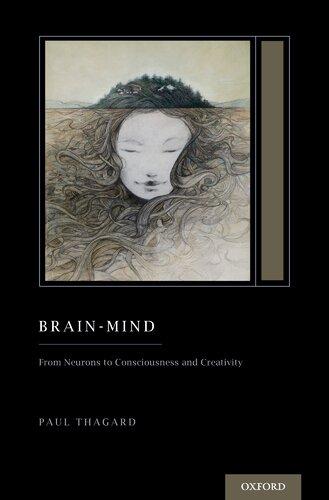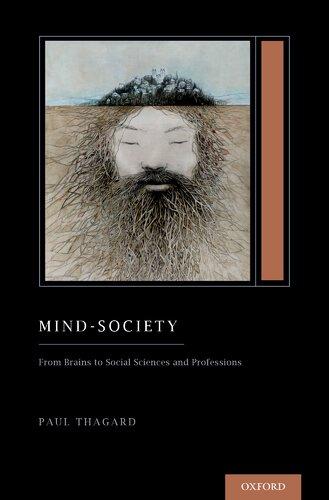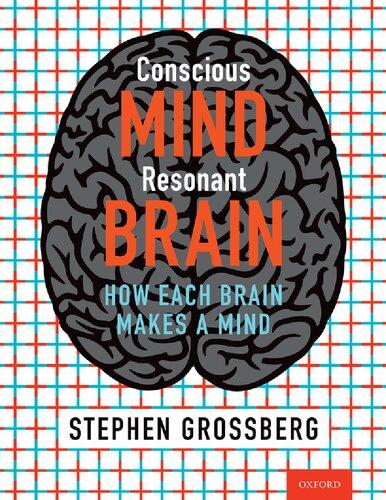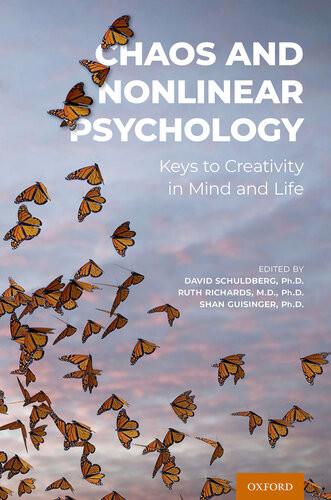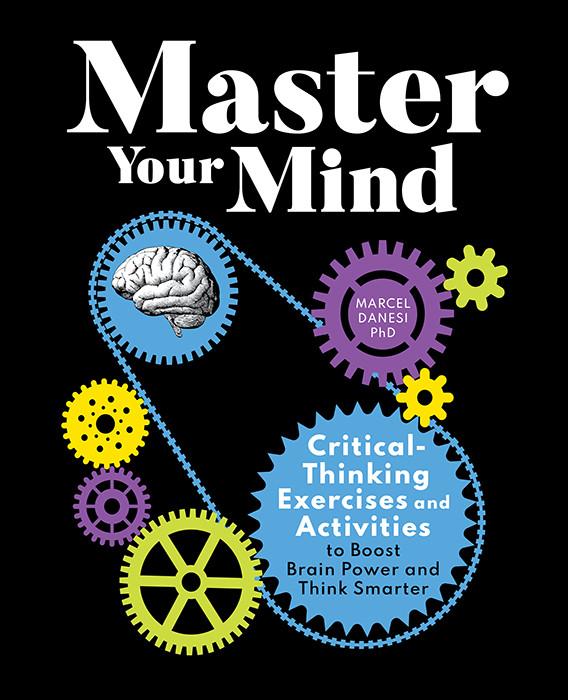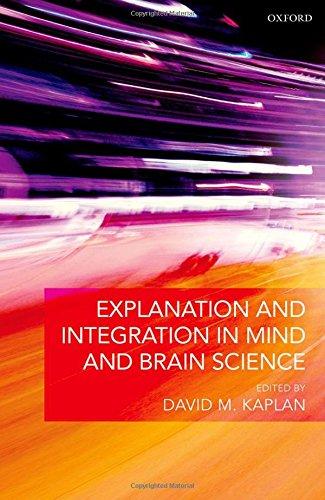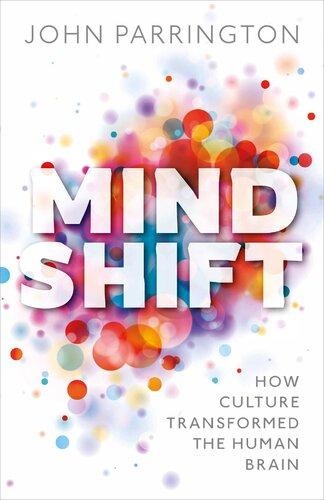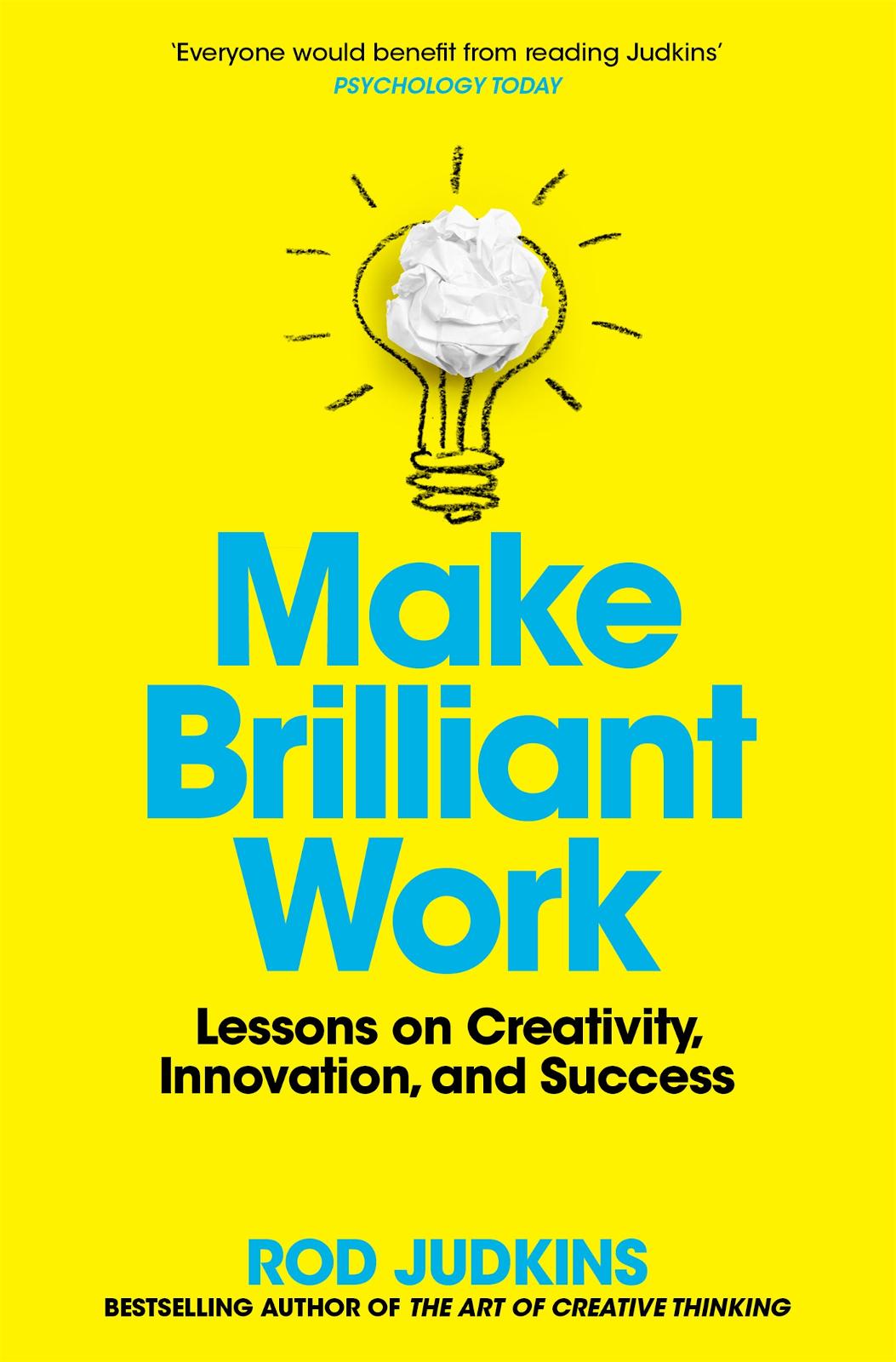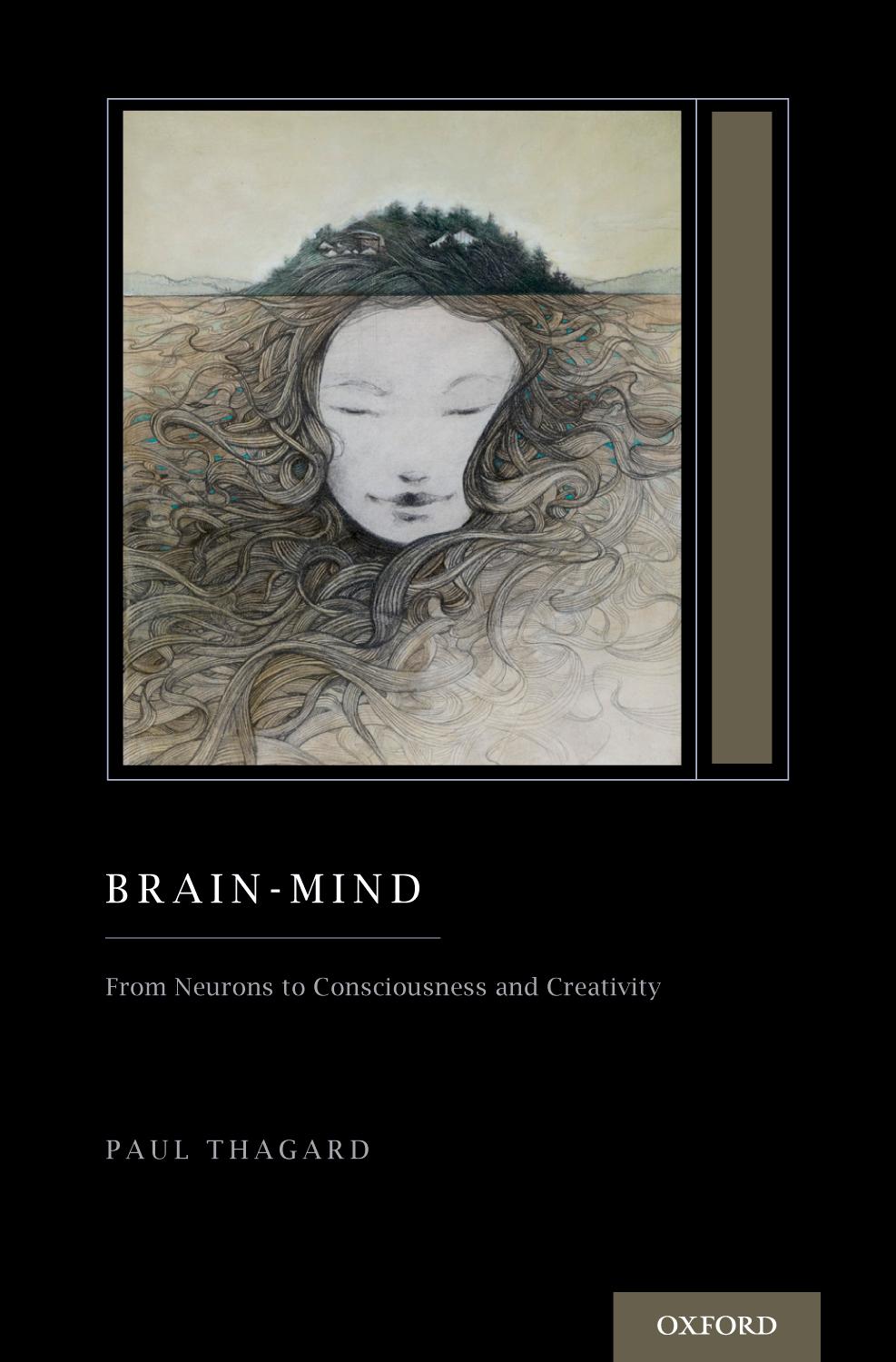Brain–Mind
From Neuro N s to Co N s C ious N ess a N d Creativity
Paul Thagard
Oxford University Press is a department of the University of Oxford. It furthers the University’s objective of excellence in research, scholarship, and education by publishing worldwide. Oxford is a registered trade mark of Oxford University Press in the UK and certain other countries.
Published in the United States of America by Oxford University Press 198 Madison Avenue, New York, NY 10016, United States of America.
© Oxford University Press 2019
All rights reserved. No part of this publication may be reproduced, stored in a retrieval system, or transmitted, in any form or by any means, without the prior permission in writing of Oxford University Press, or as expressly permitted by law, by license, or under terms agreed with the appropriate reproduction rights organization. Inquiries concerning reproduction outside the scope of the above should be sent to the Rights Department, Oxford University Press, at the address above.
You must not circulate this work in any other form and you must impose this same condition on any acquirer.
Library of Congress Cataloging-in-Publication Data
Names: Thagard, Paul, author.
Title: Brain–mind : from neurons to consciousness and creativity / Paul Thagard.
Description: New York, NY : Oxford University Press, [2019] | Includes bibliographical references and index.
Identifiers: LCCN 2018033233 | ISBN 9780190678715
Subjects: LCSH: Cognitive neuroscience. | Mind and body.
Classification: LCC QP360.5 T43 2019 | DDC 612.8/233—dc23
LC record available at https://lccn.loc.gov/2018033233
9 8 7 6 5 4 3 2 1
Printed by Sheridan Books, Inc., United States of America
To Chris, for pointing to the best semantics.
Contents
List of Illustrations xi
Foreword xiii
Preface xv
Acknowledgments xvii
1. What Are Minds? 1
Why Minds Matter 1
What Are Minds? 2
Cognitive Science 4
Representations and Processes 7
Mechanisms 9
Looking Ahead 13
Summary and Discussion 15
Notes 16
Project 17
2. How Brains Make Minds 18
Why Brains Matter to Mind and Society 18
Thinking with Cells 19
Neurons 19
Neural Groups 22
Combining Neural Representations 25
Semantic Pointers 28
The Semantic Pointer Architecture 34
Innateness versus Learning 38
Summary and Discussion 40
Appendix: Details and Comparisons 41
Notes 47
Project 49
3. Perception and Imagery 50
Why Perception and Imagery Matter to Mind and Society 50
From Sensation to Perception to Imagery 51
External Senses 53
Internal Senses 55
Imagery 56
Mental Mechanisms for Imagery 59
Neural Mechanisms for Imagery 62
Uses of Imagery 66
Summary and Discussion 68
Notes 70
Project 71
4. Concepts 72
Why Concepts Matter to Mind and Society 72
Theories of Concepts 73
Neural Mechanisms for Concepts 75
Uses of Concepts 77
Summary and Discussion 89
Notes 91
Project 92
5. Rules 93
Why Rules Matter to Mind and Society 93
Mental Mechanisms for Rules 94
Neural Mechanisms for Rules 100
Uses of Rules 103
Summary and Discussion 111
Notes 112
Project 113
6. Analogies 114
Why Analogies Matter to Mind and Society 114
Mental Mechanisms for Analogy 116
Neural Mechanisms for Analogy 119
Uses of Analogies 124
Summary and Discussion 127
Notes 130
Project 131
7. Emotions 132
Why Emotions Matter to Mind and Society 132
Psychological Theories of Emotion 133
Neural Mechanisms for Emotions 136
Uses of Emotions 143
Summary and Discussion 153
Notes 155
Project 157
8. Consciousness 158
Why Consciousness Matters to Mind and Society 158
Psychological Theories of Consciousness 159
Neural Mechanisms for Consciousness 164
Uses of Consciousness 173
Summary and Discussion 176
Notes 178
Project 179
9. Action and Intention 180
Why Actions Matter to Mind and Society 180
Psychological Theories of Action, Intention, and Will 182
Neural Mechanisms for Action and Intention 183
Uses of Action and Intention 186
Summary and Discussion 197
Notes 199
Project 200
10. Language 201
Why Language Matters to Mind and Society 201
Syntax First: Chomsky 202
Integrating Syntax, Semantics, and Phonology 204
Meaning 209
Conceptual Blending 213
Metaphor 216
Innateness and Language Learning 218
Summary and Discussion 220
Notes 221
Project 222
11. Creativity 223
Why Creativity Matters to Mind and Society 223
What Is Creativity? 224
Images 227
Concepts 229
Rules 230
Procedural Creativity 232
Analogies and Metaphors 239
Emotions 242
Case Study: CRISPR/Cas9 244
Summary and Discussion 247
Notes 249
Project 251
12. The Self 252
Why the Self Matters to Mind and Society 252
What Is the Self? 253
Semantic Pointers for Self-Representation 257
Semantic Pointer Mechanisms for Self-Effecting and Self- Changing 262
Multilevel Systems 264
Molecular Mechanisms 264
Social Mechanisms 267
Summary and Discussion 271
Notes 274
Project 275
References 277
Name Index 295
subject Index 303
List of Illustrations
2.1 Two connected neurons 20
2.2 Neural group with excitatory and inhibitory connections 22
2.3 Sketch of some major regions of the brain 25
2.4 Semantic pointers are neural representations (patterns of firing) formed by binding sensory, motor, emotional, and/or verbal representations, which are also patterns of firing in neural groups 29
2.5 Semantic pointers function to provide inferences 30
2.6 Competition between semantic pointers 32
2.7 Functioning of the Semantic Pointer Architecture 35
2.8 Simple constraint network for deciding whether to eat a banana 37
3.1 Ambiguous pictures that can be perceived in different ways depending on context and focus 55
3.2 Eiffel Tower rotated to be upside down 57
3.3 Generation of the visual image of a giraffe 65
4.1 Concept unicorn formed by conceptual combination of horse and horned 81
4.2 Neural network for competition between three concepts to determine which one best categorizes sensory input 84
4.3 The belief that the squirrel chases the rabbit results from recursive binding 85
5.1 Neural representation of a rule if representation1 then representation2 as a semantic pointer 101
6.1 Visual representation of the analogy between the solar system and the atom 120
6.2 Semantic pointer representation of the solar system 120
7.1 A semantic pointer for an emotion binds the representations of a situation, physiological reaction, cognitive appraisal, and self 137
7.2 Expanded semantic pointer for emotion, with external sensory representations for the situation, internal sensory representations for physiology, and an expanded depiction of cognitive appraisal 140
8.1 Competition for attention among texting, working, and driving 165
9.1 How intentions are formed by binding representations of a situation, evaluation, doing, and self 184
9.2 Model of intention with interactions of brain areas leading to action 185
9.3 Transitions between fast and slow modes resulting from semantic pointer mechanisms 193
10.1 Mental representation of a word as a semantic pointer integrating phonology, syntax, and semantics 205
10.2 Mental representation of a sentence as a semantic pointer integrating parts of speech, each of which is a semantic pointer combining sound, grammar, and meaning 207
11.1 Sketch of the mechanism by which CRISPR and Cas9 fight viruses 245
12.1 Grouping of many self-phenomena into six main classes: selfrepresenting (with three subcategories), self-effecting (with two subcategories), and self- changing 254
12.2 Semantic pointer for the self, resulting from binding other neural representations 257
12.3 Diagram of the self as a multilevel system 265
Foreword
Frank E. Ritter
Three decades ago, Newell, Anderson, and Simon shared a desire for a unified theory of how cognition arises and what a mechanistic explanation would look like. Today, much still remains to be done to pursue that desire, but much has been accomplished.
Allen Newell talked about narrow and deep theories, and broad and shallow theories, and that theories could differ in these ways. Many psychology theories are deep, explaining a few phenomena in great detail but not explaining many phenomena nor how they interact and mutually constrain each other.
In the trio of books making up his treatise, Paul Thagard creates a much broader and more accessible explanation than we have seen before of what a mechanistic explanation of mind and human behavior would look like. These books explain the cognitive science approach to cognition, learning, thinking, emotion, and social interaction—much of what it means to be human—and what this means for a wide variety of sciences and philosophy. His treatise provides a good overview of cognitive science and its implications. Different readers will be drawn to the treatise in different ways. It does not matter where they start. In this book, Brain–Mind, Thagard explains how the semantic pointer architecture (SPA) by Chris Eliasmith, Thagard’s colleague at the University of Waterloo, can be used to explain the mind, cognition, and related concepts. The SPA architecture is a very useful dynamic theory that can do multiple tasks in the same model, and it is explained in journal
articles and by Eliasmith’s (2013) book in the Oxford Series on Cognitive Models and Architectures. Most of the implications based on SPA are also supported by and have lessons for other computational models of cognition, so these books can be useful to users of other cognitive architectures.
In his book, Mind– Society, Thagard examines what this approach means for social science and related professional fields, and the mechanisms account for successes and failures of major professional activities. In his book, Natural Philosophy, he examines what this approach means for philosophy, including important topics of philosophy of mind and of beauty. This book provides a useful and engaging overview of philosophy, particularly for those interested in cognitive science or working in cognitive science.
These books introduce several useful theories and methods about how to do science as well. Beyond allowing and using explanations via multilevel mechanisms, particularly helpful are Thagard’s introduction and use of three-analysis for definitions and coherence. The three-analysis definitions are a way to explain concepts without using simple definitions. They define a concept using exemplars, typical features, and explanations. This approach resolves several problems with simple dictionary definitions.
Also valuable is the development of coherence as a concept for reasoning. Coherence is used in this book as a way to describe the quality of theories— that theories are not just good when they predict a single result, but how they cohere with multiple sources of data and with other theories. Coherence is hard to quantify itself, but it is clearly useful. But the use of coherence is not just normative— we should use it—it is also descriptive in that scientists and laypersons appear to already use it, at least implicitly. Making the use of coherence explicit will help us to apply, teach, and improve the process.
Not only will these books be helpful to cognitive scientists and those interested in cognitive science, they will also appeal to those who simply want to learn more about the world and cognition— they offer one of the best and broadest explanations we have for cognition. Thus, humanists and social scientists interested in knowing how cognitive science works will find some answers here.
These books contain powerful ideas by one of the most highly cited living philosophers. They can change the way you think about the world, including brains and mind, and how you might think that the mind works and interacts with the world. Thagard calls these trio of books a treatise, and I found them so compelling that I’ve decided to use them in a course this next semester.
Reference
Eliasmith, C. (2013). How to build a brain: A neural architecture for biological cognition. New York, NY: Oxford University Press.
Preface
This book belongs to a trio (Treatise on Mind and Society) that can be read independently:
Brain–Mind: From Neurons to Consciousness and Creativity
Mind– Society: From Brains to Social Sciences and Professions
Natural Philosophy: From Social Brains to Knowledge, Reality, Morality, and Beauty.
Brain–Mind presents a unified, brain-based theory of cognition and emotion with applications to the most complex kinds of thinking, right up to consciousness and creativity. Unification comes from systematic application of Chris Eliasmith’s powerful Semantic Pointer Architecture, a highly original synthesis of neural network and symbolic ideas about how the mind works. I show the relevance of semantic pointers to a full range of important kinds of mental representations, from sensations and imagery to concepts, rules, analogies, and emotions. Neural mechanisms can then be used to explain many phenomena concerning consciousness, action, intention, language, creativity, and the self.
Because of their broad importance, I have tried to make Chris’s ideas accessible to a broad audience with no special background in neuroscience or mathematics. For readability, I have omitted references from the main text, but extensive
citations are in the Notes section at the end of each chapter. These references also point to papers that provide the mathematical and computational details too technical for general presentation. Most of my papers can be found via paulthagard. com, which also contains live links for the URLs in this book.
The value of a unified theory of thinking goes well beyond psychology, neuroscience, and the other cognitive sciences. Mind– Society melds the mental mechanisms in this book with complementary social mechanisms to explain a wide range of social phenomena. The result is an integrated account of six social sciences (social psychology, sociology, politics, economics, anthropology, and history) and five professions (medicine, law, education, engineering, and business). Natural Philosophy considers the implications for the humanities of the resulting account of mind, brain, and society. The main topic is philosophy, with a systematic treatment of fundamental questions about knowledge, reality, morality, and meaning. But the book also shows the relevance of neural- social explanations to the arts, especially painting and music.
The goal of this trio of books is to harmonize the cognitive sciences, social sciences, professions, and humanities as a coherent system of thought, not to reduce one to the other. I call my general approach social cognitivism, because it combines cognitive neuroscience (including a heavy emphasis on emotions) with social processes of communication. Social cognitivism is not a new field but rather an integrated theoretical approach to thought, society, and values.
Brain–Mind has a distant ancestor in my textbook Mind: Introduction to Cognitive Science (first edition, 1996; second edition, 2005). That book covered some of the same ground by considering different kinds of cognitive theories (e.g., rules and neural networks) and several challenges to the whole enterprise of cognitive science (e.g., consciousness and embodiment). The last decade has brought major advances that make it now possible to unify what were once disparate theoretical approaches and to provide plausible answers to all of the challenges.
Acknowledgments
Most of this book was newly written in 2014–2018, but I have incorporated some extracts from other works, as indicated in the notes and in the figure and table captions. I have also used some paragraphs from my Psychology Today blog, Hot Thought, for which I hold the copyright.
I have benefitted enormously from the ideas of numerous collaborators, especially Chris Eliasmith, Tobias Schröder, and Terry Stewart. I am grateful for 23 years of grant support from the Natural Sciences and Engineering Research Council of Canada. My students in PHIL 371 furnished valuable corrections to an earlier draft, especially Lucas Connors and Louise Upton. For helpful suggestions, I am grateful to William Bechtel, Richard Carlson, Shawn Clark, Christopher Dancy, William Kennedy, Laurette Larocque, Marcin Milkowski, Jonathan Morgan, Steve Read, Frank Ritter, Jose Soto, and anonymous reviewers. I thank Joan Bossert for editorial advice, Phil Velinov and Shanmuga Priya for organizing production, Alisa Larson for skilled copyediting, and Kevin Broccoli for professional indexing. CBC Radio 2 and Apple Music provided the accompaniment.
What Are Minds?
Why Minds Matter
Marvin Minsky wrote: “What magical trick makes us intelligent? The trick is that there is no trick. The power of intelligence stems from our vast diversity, not from any single, perfect principle.” This book will argue that the diversity of mind that makes people intelligent comes from different kinds of mental structures such as images, concepts, rules, analogies, and emotions. But this diversity has an underlying unity, because all of these structures come from the same basic set of brain processes. Intelligence— the capacity to solve problems, learn, understand, reason, act, and manage other mental functions—requires neural mechanisms for representation, transformation, and competition. All these mechanisms employ special neural entities that Chris Eliasmith calls semantic pointers, whose operation will be explained in chapter 2.
Why should you care about how the mind works? The answer is easy if you are interested in topics like these: good decisions, personal relationships, mental health, language, emotions, consciousness, free will, creativity, politics, economics, history, literature, music, religion, artificial intelligence, robots, or human–machine interaction. Engaging in these concerns requires a mind that enables you to think about what you are doing when you pursue them on your own or through interactions with other people. Knowing how the mind works, and why it sometimes fails to work well, should help you to understand the successes and failures of people in the full range of human pursuits.
Perhaps you think you already know how minds work, just from having experience with your own thoughts and ability to speak about mental ideas such as belief, desire, and feeling. That assumption would make you as naïve as people who think they can understand the world without any knowledge of physics, chemistry, and biology. Introspection and ordinary language are as limited in what they can tell us about mental operations as they are about topics such as gravity, chemical bonds, and natural selection. Fortunately, great progress has been made in the interdisciplinary field of cognitive science that provides insights into how minds work and sometimes fail. This book describes basic neural mechanisms that can explain the full range of human thinking, from problem solving to emotions and consciousness.
What Are Minds?
Dictionary definitions of the word “mind” are not very informative, making vague reference to whatever makes people capable of thinking, perceiving, willing, feeling, and so on. As chapter 4 argues, we usually do not understand concepts by giving them strict definitions but rather by identifying exemplars (standard examples), typical features, and explanations. What I call “three-analysis” is the method of characterizing a concept by specifying these three aspects rather than by giving a definition using necessary and sufficient conditions. Let us now apply three-analysis to the concept of mind by examining its exemplars, features, and explanations. Table 1.1 provides a concise summary.
Exemplars for minds are easy to find. Just consider yourself and all the people you know, ignoring the philosopher who responded to the question, “Are there other minds?” by saying, “Not many.” You and your friends are all examples of having a mind. For now, we should not ignore the possibility that nonhuman
Table 1.1
Three- Analysis of Mind
Exemplars People including you and everyone you know, and advanced nonhuman animals such as chimps
Typical features Sensing, perceiving, learning, thinking, deciding, feeling, acting, problem solving, communicating
Explanations
Explains: behaviors, experiences
Explained by: neural mechanisms?
animals such as chimpanzees and dogs also have minds, and we should not rule out the possibility that computers and space aliens might also turn out to have minds. But it is better first to focus on the many good examples of minds in people we know, including you, your mother, and even Justin Bieber. Typical features of these minds include capacities for
1. sensing the external world by seeing, smelling, touching, tasting, and hearing.
2. sensing internal bodily states such as pain, hunger, balance, and heat.
3. perceiving recognizable objects in the world.
4. thinking to solve problems, make decisions, and reason.
5. feeling emotions.
6. having conscious experiences.
7. having intentions and performing actions.
These capabilities should not be taken as definitional, for there may be simple minds that lack some of them, but a majority belong to most exemplars of minds. Capacities are dispositions to behave in various ways in various circumstances, as the result of underlying causal mechanisms.
We frequently use concepts to explain important observations, and we also look for explanations of the phenomena described using the concept. The six features just listed enable minds to figure prominently in explanations of why people behave the ways they do, because their behavior is caused by their sensations, thoughts, emotions, and intentions. For example, we can explain why two people got married by supposing that they love each other, where love is an emotional mental state.
To take these explanations beyond the superficial ones used in everyday life, we need a theory that tells us what minds are and how they work. For example, the concept of love becomes much richer if we can explain what makes two people fall in love. Here are some historically important claims about the nature of mind.
1. Minds are souls. This theory is assumed by religions such as Christianity, Islam, and Hinduism that presuppose that minds survive death, which requires that minds be separable from mortal bodies.
2. Minds are fictions. Behaviorism, which dominated psychology from the 1920s through the 1950s, claimed that science requires avoiding postulating nonobservable entities like mental states and processes and should only study how behavior is shaped by physical environments.
3. Minds are computers. The development of computational ideas in the 1940s and 1950s provided a new way of understanding how minds work by analogy to computer programs. On this view, thinking is not just analogous to computing—it is computing.
4. Minds are brains. Rapidly increasing knowledge about how brains operate using billions of neurons has encouraged the identification of mental operations with neural processes.
5. Minds are dynamical systems. A dynamical system is a collection of interacting objects and states whose changes are describable by mathematical equations. Minds are embodied systems capable of perception and action.
6. Minds are social constructions. Thinking should not be understood as a capability of isolated individuals but rather as the result of interactions among people who are part of a society.
Depending on your background, you may view one of these theories as obviously true and the others as ridiculous.
We shall see that these views are not as incompatible as they might seem. The first theory does conflict with a scientific approach to the mind, because it places mind beyond the standard scientific tools of experiment and theorizing. In contrast, the other five ways have affinities. My main emphasis in this book will be on the fourth theory— that minds are brains—but we will also see the relevance of ideas about behavior, computation, dynamical systems, and social interactions. The theory that minds are brains can be greatly enriched by understanding how neural operations employ representations and computations to help us interact dynamically with the world and other people.
Cognitive Science
Cognitive science is the interdisciplinary investigation of mind and intelligence, combining insights from psychology, neuroscience, linguistics, philosophy, anthropology, and computer modeling. It began intellectually in the 1950s when visionaries such as Herbert Simon, Marvin Minsky, and George Miller realized that understanding the mind could not be accomplished using the ideas and methods from any single field. This realization was institutionalized in the 1970s when the term “cognitive science” was coined and the Cognitive Science Society was formed. Today, cognitive science is a thriving interdisciplinary enterprise
with multiple journals, annual conferences, and programs at many universities worldwide.
The first key assumption of cognitive science is that the mind can be studied scientifically by combining experimental studies and theoretical explanations of the results of those studies. This assumption rules out the claim that minds are supernatural entities like the souls assumed by many religions and also the claim that the mind is just too complicated to be subject to scientific explanation. The second key assumption of cognitive science is that no one field such as psychology, neuroscience, or philosophy has a monopoly on the ideas and methods needed to gain a full understanding of mind. Rather, cognitive science requires embracing and synthesizing ideas and methods from many fields.
This book will treat cognitive science as the integration of disciplinary insights, not just the sum of what various disciplines have learned about the mind. A third key assumption of cognitive science, shared by the theories that minds are computers and that minds are brains, is that mental operations can be understood in terms of representations and processes that operate on them. The next section will describe how these explain mental activities.
First, I want to provide a brief introduction to the main fields that currently constitute cognitive science. The most ancient is philosophy, which has been concerned with the nature of mind since the ancient Greek thinkers, Plato and Aristotle. Like many later philosophers, Plato tried to understand the mind by abstract reasoning alone, using thought experiments to determine how the mind must work. Aristotle’s approach to mind was more biological, and many subsequent philosophers, from Locke and Hume to many current ones, have tried to tie the understanding of mind to scientific findings. From a cognitive science perspective, the most valuable contributions of philosophers have been their concerns with generality, dealing with broad questions about the nature of mind that cross many disciplines, and with normativity, dealing with how minds should work better as well as with the descriptive question of how they do work. On this view, the best method for philosophers is to integrate and reflect on scientific advances, rather than to delude themselves that thought experiments alone can provide information about the mind.
Psychology emerged as an experimental field distinct from philosophy in the 1870s. Led by pioneers such as Wilhelm Wundt and William James, psychology shared philosophy’s concern with mental states but adopted a different method of systematic observations and careful experimentation, with theories aimed at explaining these findings. During the first half of the twentieth century, psychology became dominated by behaviorism, the doctrine that a scientific approach to mind should avoid theorizing about mental states and processes and
stick to understanding how environmental stimuli produce behavioral responses. One of the spurs to the cognitive revolution that hit psychology in the 1950s was growing realization that even the behavior of rats could not be explained without considering mental processes. Today, psychologists still conduct behavioral experiments but often combine them with neural measurements and computational theorizing.
Modern neuroscience began in the 1880s with the realization by Santiago Ramón y Cajal that brain functioning is due to cells that were later called neurons. Neural explanations of thinking were thin, however, until the 1980s when two major developments occurred that produced the rise of a new subfield, cognitive neuroscience. The first experimental development was the introduction of new techniques for neuroimaging, including positron emission tomography and functional magnetic resonance imagery (fMRI). The second theoretical development was the creation of new mathematical techniques for studying neural networks and modeling how groups of neurons can carry out complex cognitive functions. The next chapter will describe in more detail how basic ideas from cognitive neuroscience explain mental processes.
The scientific study of language is called linguistics, which has a big place in cognitive science because of the importance of language in human thought and communication. At the same time as psychologists were beginning to throw off the shackles of behaviorism, Noam Chomsky attacked behaviorist accounts of human language and began to develop alternative theories that explained human linguistic capabilities in terms of mental representations of syntactic structure. Subsequently, linguists have moved beyond syntax (grammatical structure) to also consider semantics (meaning) and pragmatics (purpose and context). The brain is a marvelous engine for integrating syntax, semantics, and pragmatics in the generation and comprehension of language. Linguists use various methods including the collection of grammatical intuitions of speakers of one language and the cross- cultural investigation of differences in the thousands of languages spoken worldwide.
The social aspects of language are also part of anthropology, which studies the origins, distribution, social relations, and culture of human beings. Culture is the way of life of a society, including its beliefs and behaviors. Whereas philosophy, psychology, neuroscience, and linguistics have largely been concerned with thinking in individuals, anthropology recognizes that cognition also has many important social dimensions. Along with sociology, economics, and political science, anthropology helps to expand the study of cognition to encompass social mechanisms that enable people to function in groups and to accomplish tasks that would be beyond the capabilities of any individual. Anthropology thus
overlaps with social psychology, which has become increasingly concerned with cultural matters.
The final major field contributing to cognitive science is computer modeling. The introduction of computational ideas in the 1940s and 1950s provided new theoretical ideas for understanding mental processes, and computers also contributed a new method. Building and testing theories about the mind is difficult because mental operations are not easily captured by a few mathematical equations. Instead, researchers can write computer programs that incorporate theoretical claims about thinking and then run the programs to see whether they produce results similar to what people do. A crucial part of the rise of cognitive science in the 1950s was the creation of the new field of artificial intelligence, which tries to get computers to perform tasks that require intelligence when people do them. There has been a regular flow of ideas among computer modeling, psychology, and neuroscience that has contributed to all three. Computational ideas from artificial intelligence have stimulated theorizing in psychology and neuroscience, while attention to how minds and brains work has suggested new computational approaches. Computer modeling is also now contributing to the understanding of social processes because computers can simulate the interaction of multiple intelligent agents.
Later chapters will provide much more information about the ideas, methods, and interactions of these six fields that contribute to cognitive science. We will see how the investigation of all kinds of thinking, from perception to high-level reasoning, can benefit from integrated multidisciplinary insights. The six disciplines just mentioned are the main contributors to the theories and methods of cognitive science, but many other fields are relevant, from professional areas such as education and law to humanistic areas such as literature and music.
Representations and Processes
To understand how minds work from a cognitive science perspective, you need to grasp two central ideas: representation and process. A representation is something that stands for something, and the most familiar kinds of representations are words. I follow the convention of using quotes to indicate linguistic entities such as words and sentences, and italics to indicate mental representations such as concepts. For example, the word “tree” stands for trees in the world, which your mind understands using the concept tree. Verbal representations can be combined into sentences, as when someone says that “A tree grows in the forest,” which is a representation that stands for a state of affairs in the world. It is a mistake,
however, to suppose that all representations are verbal. A picture of a tree is also a representation of it, as is a heard sound that reproduces the rustling of leaves. In a computer, a representation might just be a string of zeros and ones that also stands for trees. Many kinds of visual representations are in everyday use, such as maps, diagrams, and clocks.
To explain thinking, we need to consider representations that operate inside people’s heads when they use a mental state or process to stand for something else. Here are some examples of mental representations that you can easily acquire: the look of the Eiffel Tower, the smell of grass, the taste of wine, the touch of sandpaper, the sound of a guitar, the sadness of losing a friend, the joy of winning a contest, the feeling of pain, and the urgency of a full bladder. Like words, these representations can be combined, as when you imagine yourself drinking wine on the lawn in front of the Eiffel Tower after winning a race with sore feet. Behaviorists rejected the existence of mental representations because they cannot be directly observed, but science often proposes nonobservable entities such as electrons and black holes that are accepted because they provide good explanations of observed facts. Similarly, cognitive science proposes various kinds of mental representations, including sensory images and verbal concepts, to explain many kinds of thinking.
Representations by themselves do not explain thinking, however, because on their own they do not do anything. Hence, we need to add the second central idea of cognitive science: mental process. A process in the world is a series of operations or changes that bring about a result. For example, the process of digesting food requires operations that include chewing, swallowing, dissolving, absorbing, and excretion. Similarly, a mental process occurs when your mind carries out a series of operations that together accomplish a result. For example, if you need to decide what clothes to wear, you can imagine yourself wearing various outfits and weigh their relative attractiveness. I have already mentioned one important kind of mental process— combination— that serves to build the sentence “A tree grows in the forest” out of the words “tree” and “grows” and to build the scenario of you at the Eiffel Tower out of sensory images of different kinds. Another important kind of mental process is inference— for example, when you use the beliefs that there is a tree in the forest and that trees have roots to conclude that there are roots in the forest. A mental process takes one or more mental representations and transforms them into other representations. Inference is different from reasoning, which is an explicit verbal process, whereas inference can be unconscious and nonverbal.
Mental representations and processes are not directly observable by our senses, so it helps to understand them by analogy with more familiar things. Consider, for
example, a food recipe, which consists of a list of ingredients and a set of instructions for what needs to be done to the ingredients. To make macaroni and cheese, you need to boil the noodles and mix them together with cheese and other ingredients. Boiling and mixing are processes that are applied to macaroni and cheese to produce the desired result, something to eat. Similarly, mental processes such as combination and inference apply to sensory and verbal representations to produce desired results such as solving problems.
A more technical analogy will make sense to readers who have some familiarity with computers. A computer program consists of data structures such as numbers, strings, lists, and arrays that can be manipulated by precisely defined algorithms that perform tasks such as addition, sorting, and searching. Before the development of computers, theorizing about the mind was hindered by weak analogies to currently available mechanical analogies, such as clockworks, vibrating strings, and telephone switchboards.
The advent of computational ideas provided a more appropriate analogy, suggesting that mental representations and processes are like the data structures and algorithms that are familiar in computer programming. These computational analogies were remarkably fertile in the beginnings of cognitive science but have since been challenged by very different ideas about representation and processes derived from neuroscience. The next chapter will describe how processes operating on groups of neurons can produce representations and perform operations on them. We will see that these representations and processes are still computational but differ from the operations of most current computers. For example, processes in brains do not proceed step by step but rather require the simultaneous, parallel action of billions of neurons.
The ambition of cognitive science is to show that the full range of human thinking—including perception, problem solving, learning, language, emotions, and consciousness— can be explained by interacting representations and processes. Fulfilling this ambition has major implications for a vast range of important applications including the social sciences, but understanding the social dimensions of human thought requires attention to mechanisms that go beyond mental representations and processes.
Mechanisms
Around 2,700 years ago, the ancient Greek philosopher Thales initiated scientific explanation in terms of natural processes such as water waves. Before then, the dominant form of explanation of events was theological: What happens is the
result of the actions and will of the gods. In contrast, natural explanations are often mechanistic, explaining observations as the result of systems of parts whose interactions produce regular changes. For example, a mobile phone is a mechanism with many parts, such as the screen, computer chip, and antennae, which interact in ways that enable people to make calls and carry out Internet tasks. Cognitive explanations in terms of representations and processes are also mechanistic, with representational parts that interact by virtue of mental processes to produce changes in representation that lead to actions. Table 1.2 provides a threeanalysis of the concept of mechanism that is more informative than a simple definition of a mechanism as a combination of connected parts whose interactions produce regular changes.
People often react negatively to the suggestion that thinking is mechanistic. Does that mean you are just a robot with no will or imagination? Well, you are obviously much more complicated than any current robots, whose abilities are restricted to limited tasks. You certainly have imagination, because you can combine representations together to produce ones that are novel, such as thinking what you would look like with a hawk perched on your head. Assessing whether you have free will requires a neural theory of intention and action like the one presented in chapter 9. Putting prejudice aside, I hope that you can at least entertain the hypothesis that thinking is mechanistic, a hypothesis that gains credibility from the increasing availability of neural explanations of thinking. Such explanations are clearly mechanistic, because brain changes result from interactions of billions of neurons.
Part of the resistance to mechanistic explanations of mind is that familiar mechanisms like bicycles and can openers seem too simple to account for anything as complex as thinking. In contrast, today there are mechanisms like smart phones and robots that can carry out much more complicated tasks. We will see in chapter 2 how complex mechanisms like neural networks can have emergent
Table 1.2
Three- Analysis of Mechanism
Exemplars
Machines such as bicycles, physical systems such as the solar system, organisms such as bacteria, organs such as the brain, groups such as political parties and markets
Typical features Wholes, parts, connections, interactions, regular changes
Explanations
Explains: changes in parts and wholes
Explained by: underlying mechanisms inside parts
properties that are different from the sum of their parts. An emergent property belongs to a whole but not to any of its parts and is not the aggregate of the property of the parts because it results from the interactions of the parts. For example, water is liquid at room temperature, even though the hydrogen and oxygen that make it up are gases. To take a social example, a group of adolescents may engage in a risky social behavior such as stealing a car that no individual would do alone. Even machines can have emergent properties, for example, a bicycle that can carry people through the interactions of its parts such as wheels and handlebars, none of which can carry people.
Emergence is an important result of social mechanisms such as communication and emotional contagion, a process in which emotions spread through a population. Mental mechanisms consist of interacting representations, but social mechanisms consist of interacting people. It may seem demeaning to think of people as parts in a mechanism, but doing so provides a helpful way of understanding how societies operate. Each person has properties and relations, including mental representations and processes. People interact by various forms of communication that transfer verbal and other kinds of information including emotional reactions. Chapter 12 will provide a much more detailed account of a variety of social mechanisms that are important for understanding the self.
Table 1.3 summarizes four levels of mechanisms relevant to explaining human thinking. The aim of this book is not to reduce one level to another— the social to the mental, the mental to the neural, or the neural to the molecular. Rather, it will show the usefulness of considering mechanisms at all of these levels, taking into account their interactions rather than trying to identify one level as fundamental. For example, in explaining people’s shopping behavior, it helps to go down to the
Table 1.3
Four Levels of Mechanisms Relevant to How the Mind Works
Level Parts
Interactions Changes Results
Social People Communication Group behavior
Mental Mental representations
Neural Neurons
Molecular Genes, proteins, neurotransmitters
Processes such as inference Shifts in representations
Electric/chemical transmission
Chemical reactions
Neural firing patterns
Neural properties
Social practices
Thought, action
Representations, inferences
Neural firing
